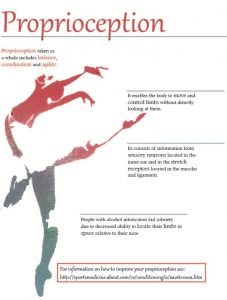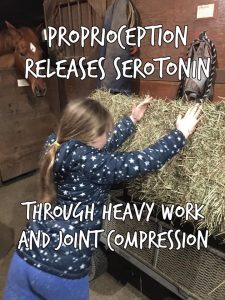 Proprioception describes the ability to know where all of your body parts are in the space around you without having to look at those body parts. When you have a well-functioning proprioceptive system, you are able to move quickly and freely without having to consciously think about where you are in space or in your environment. Proprioception is a constant feedback loop between your brain and your muscles and joints. Your joint receptors and muscle fibers tell your brain what position you are in and what forces are acting upon your body at any given point in time.
Proprioception describes the ability to know where all of your body parts are in the space around you without having to look at those body parts. When you have a well-functioning proprioceptive system, you are able to move quickly and freely without having to consciously think about where you are in space or in your environment. Proprioception is a constant feedback loop between your brain and your muscles and joints. Your joint receptors and muscle fibers tell your brain what position you are in and what forces are acting upon your body at any given point in time.
Proprioception allows you to control the force and direction of your movements to complete a task.
The way we can tell that an arm is raised, even when our eyes are closed, is through the communication between your arm and brain. This communication tells us what speed is best for the activity, how much force to use, how far to move it, and when to hold the arm still. The sensory impulses originating in the neck and ankles are especially important. Neck receptors indicate the direction in which the head is turned. Cues from the ankles indicate the body’s movement on both the standing surface (floor or ground) and the quality of that surface (hard, soft, slippery, or uneven). More specific examples of how proprioception helps us include writing with appropriate force, walking without looking at the ground, jumping at the right time on a trampoline, allowing enough space between self and others, typing while looking at the screen instead of your fingers, pressing the foot pedals while driving, and so much more!
When proprioception fails to do its job, a person is not able to tell where their body parts are in space. Children with poor body awareness tend to appear clumsy or rough, tripping, crashing, and falling on themselves, others, and objects. Handwriting can present as sloppy and with too little or too much pressure when using the writing utensil. These kids can be the ones falling out of their chairs and slouching in their seats, but they can also be the aggressive kid who is pushing and shoving others. Poor proprioception can lead to fear of the playground, running, or high energy tasks, yet it can also lead to a seeking of more physical activities like football or soccer that including a lot of crashing and wrestling. Poor proprioception can even mimic ADHD symptoms as some kids can’t sit still and appear to struggle with maintaining attention while others don’t move much at all and struggle to stay alert. How tricky that poor body awareness can present in so many different ways!
You can provide the necessary proprioceptive input through many different approaches and activities. The brain needs deep pressure provided to the body to increase the strength of the message coming in.
Improving proprioception is fun and easy.
Examples of deep input activities:
- big bear hugs
- pushing a wheelbarrow

- obstacle courses
- jumping jacks
- yoga
- rolled in a blanket and squished
- tree climbing
- mixing cookie dough
- pressing playdough
- Twister
- use of weighted vests and blankets
- swimming
- softball and soccer
- gum chewing
Poor proprioception can really impede a child’s ability to function at his/her best. When children struggle with body awareness, they also struggle academically, socially, physically, and even nutritionally. If you notice your child struggling to tell where their body is in space, contact your local occupational therapist and learn how to help your child feel comfortable in his/her own skin.
